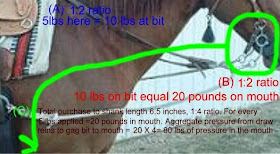There’s an old, and highly accurate saying: When you combine ignorance and leverage, you get some pretty interesting results.
Sometimes you get a horse flipping over, sometimes you get a horse panicking and bolting off and sometimes you get a really nasty fall as a horse struggles to keep upright, but can’t because his head is leveraged down.
So let's talk about layered leverage. Leverage is the basis for all bits, even snaffles. It's based on weight, gravity and resistance. With a snaffle the leverage is 1:1. You pull at one end, with your arms/body and at the other end the same amount of weight is applied to the bit. Lean your body back to augment the pull of your hand and your horse is holding up your torso weight with his mouth. Ugly to think about, but a reality.
Curb bits have leverage because of their shape. They are simple levers. Pull one end and the bit pivots around a fulcrum and places pressure on the mouth. The force is determined by the length of the shank combined with the amount of the pull. Most curbs of standard show legal length fall under a 1:4 ratio, meaning the purchase is 1/4 of the shank length. 5 pounds on the reins translates to 20 pounds in the mouth.
Gag bits are simple pulleys, whether draw gags or curb action gags. They work off of a 1:2 ratio. Whatever pressure you put on the reins is doubled in the mouth. It's the same principle as lifting a heavy object; a pulley allows us to lift double the weight. Put five pounds on the reins of the average shanked gag and when the cannons invert the purchase to shank ratio you've got 40 pounds in the mouth because the bit increases the leverage action and rachets it harder. The curbstrap doesn't stop the cannons from moving up, it just stops the purchase from rolling forward.
Draw reins are a 1:2 ratio leverage addition. Put them on a snaffle bit and they change a 5 pound pull to a 10 pound pull. Put them on a gag action curb bit and they change a 5 pound pull to an 80 pound pull. Why? Because each layer of pulley you add reduces the amount of pressure you apply and increases the amount of force at the end of where the energy is dispersed. The force has to go somewhere and in this case it's the horse's tongue.
Does your horse deserve layered leverage? No. It’s a sign of being a poor trainer without a modicum of scientific knowledge about how bits and training equipment work. It puts you at a truly unfair advantage that the horse can only equalize by freaking out. And when that happens you both lose. I have never seen a horse made better by it, but I have seen many horse ruined by the ignorant used of layered leverage.
So don't layer leverage. You're applying more force to your horse's mouth than you think.
Tracy Meisenbach
Copyright 2-2014
Do not repost or publish without written permission

No comments:
Post a Comment